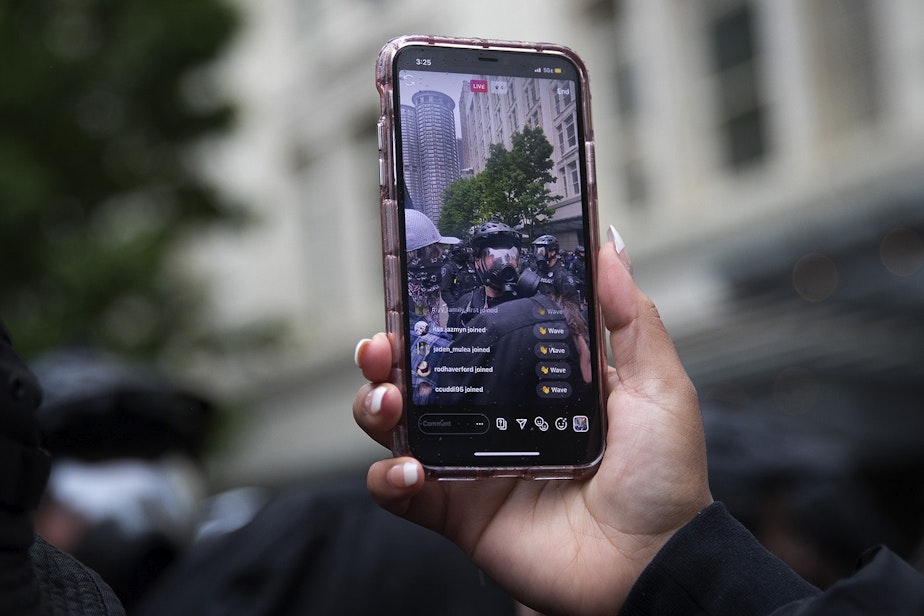Seattle OPA starts delving into complaints over SPD handling of protests

Seattle’s Office of Police Accountability is being flooded with complaints and has opened more than a dozen investigations into the Seattle Police Department's treatment of protesters in recent days. Reporter Amy Radil spoke to KUOW’s Kim Malcolm about how the civilian-led Office of Police Accountability will look at potential misconduct.
Kim Malcolm: What do we know about the complaints so far?
Amy Radil: I spoke to the office’s director Andrew Myerberg. He says they’ve received over 12,000 complaints from this weekend. The case of a child allegedly pepper-sprayed by a police officer stands out so far. He said, “we would estimate that 11,000 -- if not more -- of the 12,000 were about that one incident.”
Malcolm: A lot of people reacted to the video of the child crying as people pour milk in her eyes and try to help her. And on social media people blamed a specific officer for doing that.
Radil: Right. So Andrew Myerberg says they’ve been delving into that case already.
Myerberg said, “We reviewed that officer’s video and other body-worn video, and were able to mirror it against private party video on Twitter. We’re able to identify the moment pepper spray is dispersed. The officer alleged to have done it was at the other end of the bicycle line and could not have done it and did not disperse pepper spray. However, we identified another officer that we believe did, so that will be investigated.”
Sponsored
Malcolm: So trying to counter some of the initial reports on social media. We’ve seen other allegations and videos that seem to depict excessive force in making arrests, what will happen there?
Radil: There are actually more than 12 separate cases that the OPA is looking at right now. There were ten announced yesterday and Myerberg mentioned two more to me this morning, they include a takedown of a protester by a bicycle officer, and then the general outcry over the tear gas, flash bangs and other tactics to disperse protesters on Capitol Hill last night after police declared that a riot was breaking out.
Another case concerned video of police officers breaking glass to enter the Target store downtown. SPD has said the windows were already broken, and officers were breaking out more glass so they could enter and arrest burglary suspects. OPA will do its own investigation to verify the circumstances.
Malcolm: And one of the big concerns is whether officers used their body-worn video cameras appropriately?
Radil: Yes, OPA will release findings on that. Under SPD policy, officers are not supposed to turn cameras on when witnessing a peaceful protest or anything termed First Amendment-protected activity. But they are supposed to activate the cameras when they perceive a violation of the law and move to intervene. So Myerberg says they are reviewing that body camera video and video that members of the public are submitting, to get a more global view of each incident.
Sponsored
He said, “There is a significant amount of body-worn video particularly for incidents we are investigating, because they all occurred when officers identified that they perceived there to be violations of law and thus turned on their body worn video.”
Malcolm: So the Office of Police Accountability will investigate these complaints and put out findings. Then what happens?
Radil: They’ll make recommendations to Chief Carmen Best about whether an officer should receive training or discipline. Then it’s up the Chief and the officer has the right to appeal any decision.
Malcolm: Seattle recently sought to end the federal court’s oversight of the consent decree process. Will these protests make a difference?
It’s not clear – our status right now means we still have a federal monitor in addition to offices like the OPA. U.S. District Judge James Robart has been involved in scrutinizing SPD for years now and Myerberg says he could still weigh in. “The judge still has jurisdiction over the Seattle Police Department. I wouldn’t be surprised if the judge also has questions over how the SPD has been monitoring and policing these protests," Myerberg said.
Sponsored
Malcolm: What can we expect to see next?
Radil: Myerberg says he’s trying to move quickly and transparently, he says he’ll provide updates on what his office is looking at, and he hopes to produce findings on a rolling basis, the first as early as a month and a half from now.
And then we have another body, the Office of Inspector General, headed up by Lisa Judge, who has the ability to do a broader analysis of SPD’s response to these protests, whether they fit with city laws and policies and best practices. Myerberg said these analyses are essential, “And I think there has to be some community input in that process.”
We’ll hear from Seattle’s Community Police Commission very soon. They are expected to discuss SPD’s “demonstration management” at a meeting Wednesday June 3. Both Myerberg and Lisa Judge will be in attendance there and at the Seattle City Council meeting the same day.




